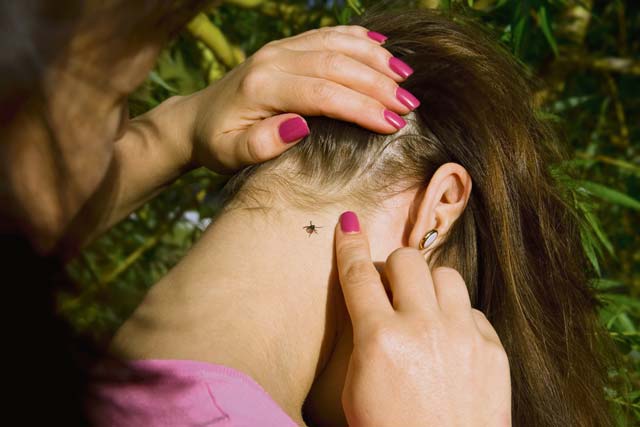
Summer is the ideal time for outdoor activities and getaways with family and friends. But with increased outdoor activities comes an increased likelihood of tick exposure, which are active from April to September. Ticks are a concern because they can carry pathogens that cause human and animal diseases. Most ticks have four life stages and must eat blood to survive each stage. It is during the feeding stage that ticks transmit pathogens to animals and humans. Ticks attach to a host, such as a bird or mammal, and suck on its blood for days before detaching to prepare for the next stage. If the host animal has a blood borne infection, then the tick will ingest it. At its next feeding, it can then transmit any acquired diseases to another host.
“In recent years, veterinary and military treatment facilities in the EUCOM AOR have submitted, on average, 200 ticks per year to the Public Health Command-Europe Entomological Sciences Division for testing, with infection rates ranging from 5 percent to 15 percent,” said U.S. Army PHC-E Epidemiologist Fritz Castillo during a telephone interview. “The majority of ticks that are submitted to the PHC-E ESD are from the Bavaria and Rheinland-Pfalz regions, and 50 percent of ticks that are submitted by MTFs are removed from children.”
Ticks submitted for testing have tested positive for Anaplasma and Ehrlichia species as well as Lyme disease and tick-borne encephalitis, the two most important tick-borne diseases of concern, since they are endemic to Germany and spreading geographically.
Disease Information
Lyme disease and TBE are transmitted through the bite of infected Ixodes ricinus ticks. Lyme disease is caused by the Borrelia burgdorferi bacterium and TBE is caused by the tick-borne encephalitis virus of the Flaviviridae family.
“Although ticks submitted for testing have tested positive for the TBE virus, the bacterium Anaplasma phagocytophilum, which causes anaplasmosis, and the Ehrlichia bacterial species, which cause ehrlichiosis, the most prevalent tick-borne disease is Lyme disease,” Castillo said. “And of the 256 Lyme disease cases diagnosed from 2010 to 2012, only 37 percent exhibited signs of erythema migrans skin lesion, the typical bulls-eye rash associated with Lyme disease.”
This high asymptomatic rate is why the public health community recommends that any individual who has had a tick attached for longer than a day be tested for Lyme disease, rash or no rash. Left untreated, Lyme disease can progress to the late stage and become chronic, leading to musculoskeletal, neurological or cardiac problems.
Disease Prevention
There are precautions to take to prevent or reduce chances of getting Lyme disease or other tick-borne diseases. Here are a few tips from the Centers for Disease Control and Prevention (CDC):
• Before going outdoors, know where to expect ticks — ticks like moist and humid environments near wooded or grassy areas.
• Always walk in the center of trails to avoid contact with ticks; use insect repellents containing 20 percent or more DEET, a chemical found in most insect repellents, on exposed skin and soak protective clothing, boots or shoes and gear with products containing 0.5 percent permethrin.
• After coming indoors, check clothing for ticks.
• Shower soon upon return to reduce risk of getting Lyme disease since showering may help remove unattached ticks.
• Don’t forget to check your and especially your children’s bodies for ticks — conduct a full-body check paying close attention for ticks under the arms, in and around the ears, inside belly buttons, behind the knees, between legs, around the waist, and in and around hair.
• Use tick control products to prevent your pets from bringing ticks into the home.
Tick Removal
If you do find a tick attached to your body, follow these steps from the CDC:
• Grasp the tick with fine-tipped tweezers as close to the skin as possible, pulling straight out.
• Clean the bite area and your hands with rubbing alcohol or soap and water and never crush a tick with your fingers.
Watch for signs of illness such as fever or rash after the bite. Symptoms may appear anywhere between three to 30 days after exposure. See your health care provider if you develop signs or symptoms after the bite.
Sending in Ticks for Testing
Tick-borne diseases can be hard to diagnose, but early recognition and treatment can decrease the risk of serious complications. If you would like to get the tick tested after removing it, you can store it in a sealable container or plastic bag and bring it to the Public Health Epidemiology section at the Ramstein clinic. For details, call the epidemiology section at 479-2086 or 06371-46-2086.
For more information on ticks, visit the CDC website at http://www.cdc.gov/ticks/.







